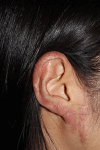Primary Cutaneous Chrysosporium Infection following Ear Piercing: A Case Report
- PMID: 26269703
- PMCID: PMC4519602
- DOI: 10.1159/000436989
Primary Cutaneous Chrysosporium Infection following Ear Piercing: A Case Report
Abstract
Chrysosporium is a large genus of saprophytic fungi that is commonly found in the soil. Infection caused by this organism is rare in humans and typically occurs in immunocompromised patients. Primary cutaneous Chrysosporium infection is relatively rare and has been reported in a heart transplant patient. The prognosis is usually favorable, but very poor in the setting of persistent profound immunosuppression. We herein report a case of primary cutaneous Chrysosporium infection following ear piercing in an immunocompetent patient. It is important for clinicians to consider this condition in patients with slow-onset skin and soft tissue infection following cutaneous injury, even in an immunocompetent setting.
Keywords: Chrysosporium infection; Ear piercing; Hyalohyphomycosis.
Figures


References
-
- The University of Iowa, Department of Pathology: Itraconazole drug level; in: Laboratory Services Handbook (update June 18 2013; cited January 29 2013). Available at: https://www.healthcare.uiowa.edu/path_handbook/handbook/test1168.html.
-
- Walsh TJ, Groll A, Hiemenz J, Fleming R, Roilides E, Anaissie E. Infections due to emerging and uncommon medically important fungal pathogens. Clin Microbiol Infect. 2004;10:48–66. - PubMed
-
- Anaissie EJ. Hyalohyphomycosis. In: Anaissie EJ, McGinnis MR, Pfaller MA, editors. Clinical Mycology. ed 2. New York: Churchill Livingstone; 2009. p. 313.
Publication types
LinkOut - more resources
Full Text Sources
Other Literature Sources

